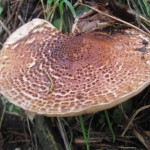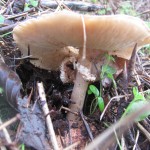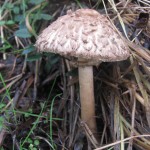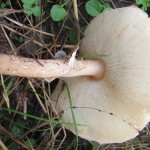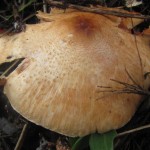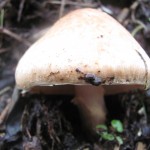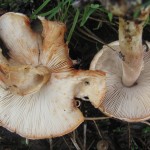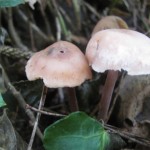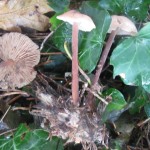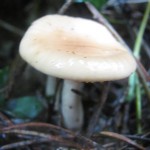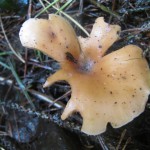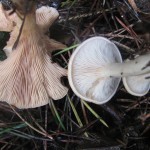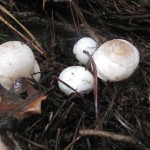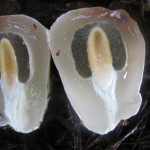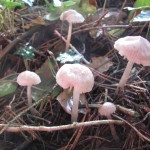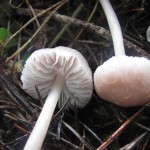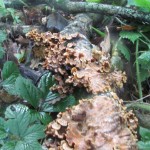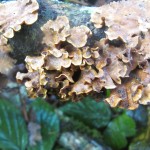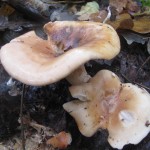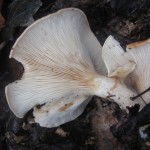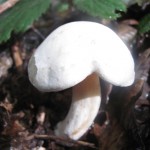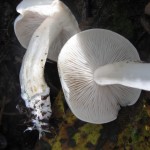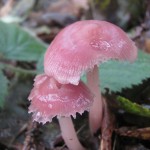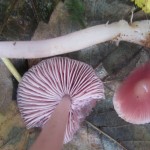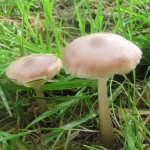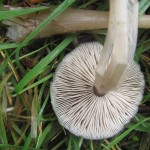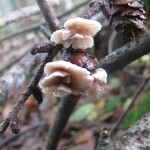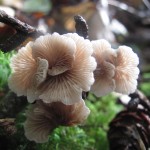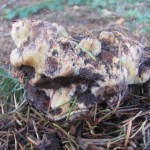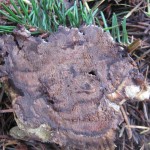We were away for a week to Cork in Ireland, and so I decided to make acquaintance with the local fungal life. There doesn’t seem to be a system of public footpaths in Ireland, so it’s a bit difficult to go to any random patch of countryside and set off across the fields. But there are quite a few public amenity woods and I spent a pleasant morning having a look around Farran Forest Park. I was astonished to find that the car park charge was €5, but I managed to park down the road a bit and it turned out well as there were 3 different mushrooms growing in the hedge bank by my parking spot.
There’d been a lot of rain so the mushrooms were rather waterlogged which tends to dampen down any smell.
1. Freckled Dapperling (Lepiota aspera).
- 1. Freckled Dapperling
- 1. Freckled Dapperling
Growing in a hedge bank. Cap 10cm. Very strong mushroomy, fungusy smell. Very crowded gills. It’s certainly a Dapperling but can’t be sure it’s Freckled Dapperling. This specimen is flat which doesn’t quite fit, but the ring with dark brown scales looks right and there aren’t so many Dapperlings that it could be at this large size. ID is fairly likely.
2. Shaggy Parasol (Macrolepiota rhacodes).
- 2. Shaggy Parasol
- 2. Shaggy Parasol
Growing in a hedge bank. Cap 4-8cm. Not much smell. The 1st picture is a smaller one and the 2nd a larger one from below. ID is very likely.
3. Unidentified.
- 3. Unidentified
- 3. Unidentified
- 3. Unidentified
Growing in a hedge bank. Cap 4-6cm. Really not sure about this one. Could be a Fibrecap (Inocybe) except it’s too big and they don’t generally have white gills. So more likely it’s a Lepiota but it doesn’t seem to fit with any of those either.
4. Unidentified.
- 4. Unidentified
- 4. Unidentified
Growing on pine needles. Cap 3-4cm. Smell sweet and mushroomy. This will be a struggle to identify.
5. Unidentified.
- 5. Unidentified
- 5. Unidentified
- 5. Unidentified
Growing on pine needles. Cap 3-4cm. Smell slight.
6. Stinkhorn (Phallus impudicus).
- 6. Stinkhorn
- 6. Stinkhorn
Seem to be growing on very rotten wood. Ball 1-3cm. No smell. Immature Stinkhorns. Thought these were puffballs until I noticed a jelly patch on one, and then cut it in half. They’re like alien eggs inside! Shame I can’t come back in a week to see them in their full phallic glory.
7. The Deceiver (Laccaria laccata).
- 7. The Deceiver
- 7. The Deceiver
Growing on pine needles. Cap 1-3cm. No smell. ID is very likely.
8. Hairy Curtain Crust (Stereum hirsutum).
- 8. Hairy Curtain Crust
- 8. Hairy Curtain Crust
Growing on beech wood I think. No smell. Very tough.
9. Tawny Funnel (Lepista flaccida).
- 9. Tawny Funnel
- 9. Tawny Funnel
Growing on leaf litter. Cap 8-10cm. Sweet smell. Slight doubt about this id as I don’t think the centre of the cap is normally a dark colour. ID is very likely.
10. Goat Moth Wax Cap (Hygrophorus cossus).
- 10. Goat Moth Wax Cap
- 10. Goat Moth Wax Cap
Growing under oak and sycamore. Cap 3-6cm. Smell a bit unpleasant. Smell a bit unpleasant, although I really can’t swear that it smells like the larva of a Goat Moth. ID is very likely.
11. Lilac Bonnet (Mycena pura).
- 11. Lilac Bonnet
- 11. Lilac Bonnet
Cap 3-4cm. ID is very likely.
12. Unidentified.
- 12. Unidentified
- 12. Unidentified
Growing in grass near a holly tree. Cap 5cm.
13. Variable Oysterling (Crepidotus variabilis).
- 13. Variable Oysterling
- 13. Variable Oysterling
Growing on pine twigs and cones. Cap 1cm. ID is almost sure.
14. Unidentified.
- 14. Unidentified
- 14. Unidentified
Growing on pine needles. Lump 10cm. Very little smell. The mycelia seem to be growing on the needles and not associated with the tree itself, as it could easily be picked up with the needles attached. Can’t find anything like it in my books.

